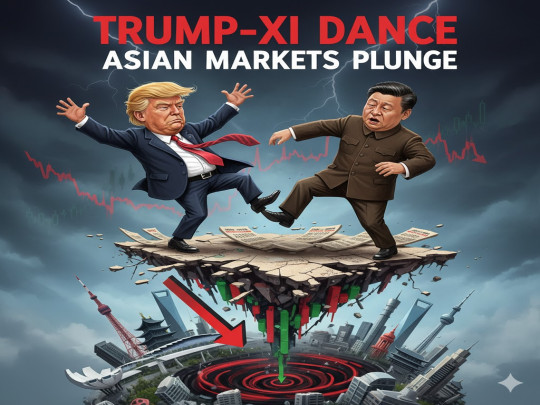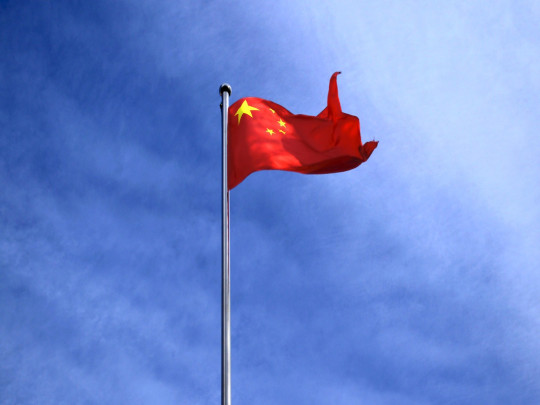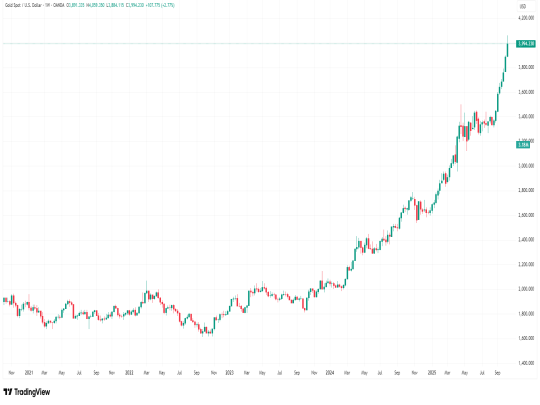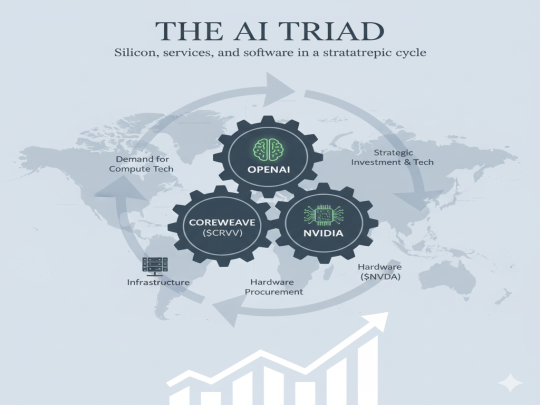Stock Market Update: S&P 500 Nears Record Highs as Nike Soars, Tesla Shakes Up Leadership, Tariff Fears Ease
Stock Market Update: S&P 500 inches toward new highs as Nike jumps post-earnings, Core Scientific rallies on buyout talks, and AeroVironment extends its surge. Tesla ousts top exec amid sales woes. Trade optimism grows after U.S.-China framework.
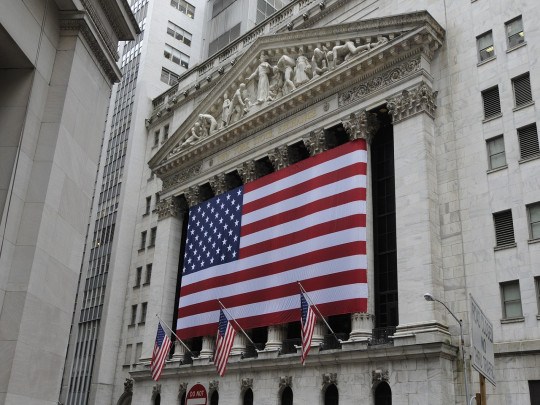
- Early Friday US stock futures pointed higher, putting the S&P 500 and Nasdaq on the brink of new records, fueled by optimism over a US-China trade framework and resilient economic data.
- The market rally, which has seen the S&P 500 surge over 23% from its April low, is supported by easing trade tensions and strong corporate fundamentals.
- Thursday saw US stocks rally strongly (S&P +0.8%), closing near all-time highs, led by gains in mega-cap tech stocks like Nvidia and a surge in the aerospace and defense sector.
- Significant premarket movers Friday included Nike (+10%) surging on a better-than-expected Q4 and an improved outlook, despite a $1B tariff warning. Core Scientific (+7%) continued rallying on reports of acquisition talks with AI firm CoreWeave. AeroVironment (+5%) extended its strong weekly run. Apogee Enterprises (+14%) jumped on a beat.
- A major breakthrough on trade saw the US and China finalize a framework agreement to ease export restrictions on items like rare earths and tech. The White House also signaled flexibility on upcoming July tariff deadlines.
- Economic data presented a mixed picture: May core PCE inflation was slightly hotter than expected (2.7% YoY), while consumer spending and income both unexpectedly fell. Thursday's data showed resilient weekly jobless claims and a surge in durable goods orders, though Q1 GDP was revised lower.
- Company news included Tesla firing a key manufacturing executive. Nike detailed a $1B expected cost from new tariffs and plans to reduce its China supply chain exposure. Chinese EV maker Xiaomi unveiled a popular new SUV model to compete with Tesla.
- Global markets Friday saw Europe advance on trade optimism. Asia was mixed, with Japan's Nikkei crossing the 40,000 mark while Chinese markets fell on weak industrial profit data.
- US Treasury yields ticked higher Friday morning (10-year around 4.27%) as investors digested the mixed economic data, particularly the hotter-than-expected core PCE reading.
- Gold prices fell over 1% Friday to a near one-month low as safe-haven demand waned. Oil edged higher but was set for a steep weekly loss (~12%) as the Mideast risk premium vanished post-ceasefire. Bitcoin saw a modest pullback.
- Market sentiment has turned decidedly bullish, with the S&P 500 on the cusp of a record high. The recovery has been driven by easing trade and geopolitical tensions, resilient corporate earnings, and hopes for a more dovish Federal Reserve.
Stock futures pointed higher on Friday as optimism over U.S.-China trade negotiations and encouraging inflation and labor market data helped push the S&P 500 and Nasdaq Composite to the brink of new record highs. Futures tied to the S&P 500 gained 0.2% in premarket trading, putting the benchmark index within a fraction of its all-time intraday high. As of Thursday’s close, the S&P 500 stood just 0.1% below that level, while the Nasdaq Composite was only 0.03% away from its own record. Both indexes ended Thursday just shy of fresh highs, underscoring the strength of the market’s rebound from the tariff-related sell-off earlier this year. The S&P has surged over 23% since its April low.
Sentiment was further buoyed by a report from the Commerce Department showing that consumer prices rose modestly in May. While inflation remains above the Federal Reserve’s 2% target, the pace of annualized gains appears to be cooling slightly. Investors interpreted the data as a sign that inflation pressures may be stabilizing without derailing economic growth. This followed news on Thursday that initial jobless claims fell to 236,000 for the week ending June 21, below the 244,000 forecast, suggesting continued resilience in the labor market.
Markets also responded positively to comments from the White House, where spokesperson Karoline Leavitt downplayed the urgency of resolving July’s tariff deadlines, which had been weighing on global trade sentiment. Her remarks eased fears of a sudden escalation in trade tensions and reinforced investor hopes that a de-escalation with China may be on the horizon. With economic fundamentals showing signs of durability and geopolitical risk receding, investors appeared willing to push equities to new highs.
US Market Previous Day:
The S&P 500 rose 0.8% on Thursday to close at 6,141.02, pushing its weekly gain to 2.9% and placing it just shy of its all-time intraday high of 6,147.43 set in late February. The Nasdaq Composite gained 0.97% to finish at 20,167.91, also nearing a new record. The Dow Jones Industrial Average climbed 404.41 points, or 0.94%, to end the day at 43,386.84, as optimism around tech and defense stocks helped fuel the rally.
Mega-cap technology names were once again central to the market’s strength. Nvidia added 0.5%, touching a new all-time high, while Meta Platforms advanced more than 2% and Alphabet rose 1.7%. Nvidia shares have rebounded nearly 80% from their April lows, as investor fears around Chinese competition and a slowdown in AI infrastructure spending have eased. The Nasdaq 100 index, which is heavily weighted toward technology, surged to a new record earlier in the week, propelled by gains in semiconductor stocks.
Defense shares also made headlines, with the iShares U.S. Aerospace & Defense ETF hitting an all-time high—its first since June 9—and heading for its third straight monthly gain. Smaller firms in the space led the advance. Rocket Lab, AeroVironment, and Karman Holdings all set new intraday highs, while Loar Holdings and Archer Aviation also posted strong gains. Year to date, AeroVironment is up roughly 75%, Rocket Lab has gained 45%, and Karman Holdings has added 68%. These moves sharply contrast with the more modest performance of traditional defense giants like Boeing, which is up 15% in 2025, Northrop Grumman (up nearly 6%), and Lockheed Martin, which has declined almost 5% for the year.
US Futures Remain Flat:
- Dow Jones Industrial Average futures remained flat with increase of 0.27%
- S&P 500 futures showed meagre gains of 0.18%
- Nasdaq Composite futures rose by 0.17%.
Biggest Premarket Movers
- Nike: Shares of the sneaker giant jumped 10% after the company posted fiscal fourth-quarter results that beat expectations. Nike also signaled that future profit and sales declines should moderate, stating that its turnaround efforts have already absorbed the largest financial impacts. The company anticipates tariffs will cost roughly $1 billion before it implements mitigation strategies like price hikes and supply chain adjustments. Following the report, HSBC upgraded Nike to "buy" from "hold."
- Trade Desk: The ad tech stock popped 4% on the back of an upgrade from Evercore ISI. Analyst Mark Mahaney highlighted that Trade Desk’s valuation appears attractive at its current level and that its risk-to-reward profile has improved.
- Core Scientific: Shares of the bitcoin miner jumped 7%, continuing a rally from the previous session. The momentum followed a Wall Street Journal report on Thursday that the company is in discussions to be acquired by the artificial intelligence firm CoreWeave. In sympathy, other hybrid bitcoin miners like Iren and Cipher Mining also advanced about 3% each, while CoreWeave shares were little changed.
- AeroVironment: Shares of the defense contractor climbed 5% in premarket trading, putting the stock on pace for its fifth consecutive day of gains. The rally was sparked by strong quarterly results reported earlier in the week, which have propelled the stock to a 43% gain week-to-date.
- Apogee Enterprises: The architectural products company rallied 14% after reporting better-than-expected fiscal first-quarter results. Apogee posted adjusted earnings of 56 cents per share on revenue of $346.6 million, surpassing FactSet analyst expectations of 47 cents per share and $325.5 million in revenue.
- Pony.ai: Shares of the autonomous vehicle company rose nearly 2% following a New York Times report that Uber is in talks to help finance an acquisition of Pony.ai’s U.S. subsidiary. The takeover attempt is reportedly being led by Uber co-founder and former CEO, Travis Kalanick.
Tariff Update:
The U.S. and China have reached a trade framework agreement aimed at easing tensions and facilitating key exports, according to statements from both governments. U.S. Commerce Secretary Howard Lutnick told Bloomberg that a formal framework with China had been finalized and that the Trump administration expects to strike similar agreements with 10 other major trading partners soon.
President Donald Trump on Thursday claimed that the U.S. had “just signed with China,” a comment later clarified by the White House to mean that China agreed to “an additional understanding of a framework to implement the Geneva agreement.” China's Ministry of Commerce confirmed Friday that the two countries agreed on a framework allowing rare earth exports to the U.S. and easing technology-related export restrictions. China will now review and approve export applications for items under its control laws, while the U.S. will lift a range of existing restrictive measures imposed on Chinese firms.
In a related development, the White House signaled that upcoming deadlines for imposing sweeping “reciprocal” tariffs on a wide range of imports could be postponed. White House Press Secretary Karoline Leavitt said Thursday that the July 8 and 9 deadlines are “not critical” and could be extended at President Trump’s discretion. She added that if countries fail to reach trade deals with the U.S. by then, “the president can simply provide these countries with a deal.”
Markets responded positively to Leavitt’s remarks, with stocks moving to session highs on hopes that trade-related volatility may be avoided. The comments also follow Treasury Secretary Scott Bessent’s June testimony before the House Ways and Means Committee, where he suggested it was “highly likely” that Trump would delay the July 8 tariff hikes.
Overall, the confirmation of a trade framework with China and the potential easing of tariff deadlines signal a more flexible posture from the Trump administration on trade, which may ease investor fears about a renewed escalation in global trade tensions.
Key Economic Data/News:
Fresh economic data on Friday painted a mixed picture of the U.S. economy, with inflation slightly firmer than expected while key components of consumer activity showed signs of cooling.
The personal consumption expenditures (PCE) price index — the Federal Reserve’s preferred inflation gauge — rose 0.1% in May, in line with economist forecasts, and increased 2.3% from a year earlier. However, the core PCE index, which strips out volatile food and energy prices, came in a bit hotter than expected. Core prices rose 0.2% on the month and 2.7% year-on-year, slightly above the Dow Jones estimates of 0.1% and 2.6%. The Fed tends to focus on the core measure as a better barometer of underlying inflation trends, and the uptick in annual core inflation from April’s 2.6% may give policymakers pause as they weigh future rate cuts.
At the same time, consumer activity showed more pronounced weakness. Personal spending unexpectedly fell 0.1% in May, missing expectations for a 0.1% increase, while personal income dropped 0.4%, sharply underperforming forecasts for a 0.3% gain. The decline in income and spending suggests households may be pulling back amid tighter financial conditions and persistent cost pressures.
Meanwhile, the labor and manufacturing data released on Thursday showed contrasting signals. Initial jobless claims dropped to 236,000, beating expectations and suggesting continued strength in the labor market, though ongoing claims remained elevated — at their highest level since November 2021 — indicating potential cracks in longer-term employment stability.
Durable goods orders surged by 16.4% in May, handily beating the 7.5% estimate and reversing a sharp 6.6% drop in April. Most of the strength was concentrated in transportation, particularly aircraft, but even excluding those volatile sectors, orders were up modestly and posted a solid year-over-year gain. The data suggested that at least some sectors of manufacturing remain resilient despite broader macroeconomic headwinds.
However, growth concerns persist. Final estimates for first-quarter GDP showed the economy contracted at a 0.5% annualized pace — weaker than the previous -0.2% reading — due largely to downward revisions in consumer spending and exports. The softer growth print added to concerns that higher interest rates and global trade frictions, including tariffs, may be weighing more heavily on U.S. output than previously thought.
Overall, the data reinforces the complexity facing the Fed: while inflation is showing signs of sticky persistence, key pillars of economic growth — spending, income, and GDP — appear to be losing momentum. Markets will now look ahead to the next round of central bank commentary for clues on whether policymakers will remain on hold or consider easing rates later this year.
Earnings Season/Company News:
Tesla CEO Elon Musk has fired Omead Afshar, the company’s vice president of manufacturing and operations, following a series of car sales declines in key global markets. Afshar, who reported directly to Musk, oversaw a team of more than six senior executives, according to internal documents. His dismissal comes amid growing pressure on Tesla’s operational leadership, with the company facing increasing competition and softening demand in important regions. His exit follows the recent resignation of Milan Kovac, former head of Tesla’s Optimus humanoid robotics program, who stepped down earlier this month citing personal reasons.
In a related development in the electric vehicle space, shares of Xiaomi surged more than 5% in Hong Kong on Friday, hitting a record high after unveiling its latest electric SUV, the YU7. The new model, positioned as a direct competitor to Tesla’s Model Y, starts at 253,500 yuan (roughly $35,322), which undercuts the Tesla equivalent by 10,000 yuan. According to Xiaomi, the YU7 received more than 200,000 orders within just three minutes of launch. CEO Lei Jun claimed the SUV outperformed Tesla’s Model Y on several specifications, although he acknowledged Tesla’s continued lead in driver-assist features. The YU7 comes equipped with advanced driver-assist capabilities, powered by Nvidia’s Thor chip, and deliveries are expected to begin within one to five weeks.
Meanwhile, Nike provided an update on its turnaround efforts, signaling that the worst may be over following a challenging fiscal fourth quarter. The sportswear giant reported better-than-expected earnings but warned that tariffs pose a new risk to profitability. Chief Financial Officer Matt Friend said that recently imposed tariffs are expected to add roughly $1 billion in incremental costs for the current fiscal year ending in summer 2026. He described the duties as a “new and meaningful” challenge and noted that Nike plans to mitigate these expenses through a combination of price increases and supply chain restructuring.
To reduce exposure to tariff-related costs, Nike intends to cut its China-based supply chain footprint from the current 16% to a high single-digit percentage by year-end. Despite these pressures, Nike’s stock rose about 9% in premarket trading, as investors welcomed the company’s proactive cost management and better-than-anticipated quarterly results.
Global Market Trends:
European markets moved higher on Friday, with the pan-European Stoxx 600 index rising 0.6% in midday trading as most sectors saw modest gains. Banking stocks led the rally, buoyed by a reduced likelihood of broader conflict in the Middle East and improving trade signals between the U.S. and China. Shares of Barclays rose to their highest level in 15 years, last trading at levels seen in April 2010. Despite the surge, analysts at Bank of America argue the stock remains “cheapest” among its peers, supported by strong earnings momentum. Automakers also contributed to the European gains, as signs of a thaw in U.S.-China trade tensions raised optimism for a de-escalation in the tariff standoff. The index was poised to notch its first weekly advance in three weeks, with other major regional indexes also trading higher.
In Asia, market sentiment was mixed on Friday as investors reacted to China’s latest economic data. Industrial profits in China dropped 9.1% year-on-year over the first five months of 2025, adding to concerns over the country’s post-pandemic recovery. Japan’s Nikkei 225 surged 1.43% to close at 40,150.79, breaking above the 40,000 mark for the first time since early January. The broader Topix also gained 1.28% to finish at 2,840.54. In contrast, South Korea’s Kospi declined 0.77% to 3,055.94, and the Kosdaq fell 0.81% to 781.56. Hong Kong’s Hang Seng Index dipped 0.17% to 24,284.15, while mainland China’s CSI 300 lost 0.61% to settle at 3,921.76. Australia’s S&P/ASX 200 benchmark closed 0.43% lower at 8,514.20.
Debt Market:
U.S. Treasury yields edged higher Friday as markets awaited the release of the Fed’s preferred inflation gauge, the Personal Consumption Expenditures (PCE) price index. Meanwhile, political tension resurfaced as President Donald Trump issued new public criticism of Federal Reserve Chair Jerome Powell. The benchmark 10-year Treasury yield rose 2 basis points to 4.271%, while the 2-year yield climbed 3 basis points to 3.75%. The 30-year yield was largely unchanged, last seen at 4.823%. Traders remained cautious ahead of the inflation data, which could influence expectations for future interest rate moves.
Commodities and Other Assets:
Gold prices fell more than 1% on Friday, hitting their lowest level in nearly a month as easing geopolitical and trade tensions reduced safe-haven demand. The metal dropped to its weakest since late May and is down over 2% for the week, marking a steep retreat of more than $200 from its record high reached in April. While a weaker U.S. dollar would typically support gold, the market instead focused on the loss of haven demand and a lack of clarity from economic indicators and central bank remarks. With mixed signals on inflation and rate policy, investors are remaining on the sidelines as they await the next key U.S. inflation report to better understand the Federal Reserve’s interest rate trajectory.
Oil prices edged higher on Friday but were still on track for their steepest weekly decline since March 2023, as the market reassessed the geopolitical risk premium that briefly pushed prices higher. During the 12-day conflict between Israel and Iran that began after Israel’s strike on Iranian nuclear sites, Brent crude had surged past $80 per barrel. However, following President Trump’s announcement of a ceasefire, prices fell sharply to $67 a barrel, pushing both Brent and WTI toward a weekly loss of about 12%. The market has now shifted its focus back to supply and demand fundamentals. Support for prices came from stronger-than-expected drawdowns in middle distillate inventories, and attention is turning to the upcoming OPEC+ meeting on July 6, where members will decide on August production levels.
Bitcoin slipped modestly on Friday, giving back some of the week’s earlier gains as investor caution returned ahead of a key U.S. inflation reading. Although the broader crypto market had seen improved sentiment this week — driven by the U.S.-brokered ceasefire between Israel and Iran and signs of rising institutional interest — the rally appeared to be losing steam. Bitcoin remains in positive territory for the week, with additional support coming from continued corporate adoption, including further Bitcoin purchases by Japanese firm Metaplanet. Still, most major cryptocurrencies traded in a narrow, slightly negative range on Friday as traders reassessed risks tied to the Fed’s next policy move.
Market Sentiment:
The S&P 500 is poised to mark a remarkable turnaround, nearing its all-time intraday high of 6,147.76 after surging 23.3% from its April 8 low. That rebound caps a dramatic recovery from a nearly 20% springtime sell-off driven by fears over President Donald Trump’s aggressive tariff agenda. Investor sentiment has shifted significantly over the past few months, as geopolitical and macroeconomic headwinds have receded and corporate fundamentals proved more resilient than initially feared.
Key to the index’s recovery has been a de-escalation in trade tensions. Trump’s decision to dial back the most severe tariffs on key U.S. trading partners helped remove a major overhang for both markets and businesses. At the same time, second-quarter corporate earnings surprised to the upside. Earnings for S&P 500 companies rose 4.9% year over year, according to FactSet, marking the eighth consecutive quarter of profit growth. That performance, in the face of continued policy uncertainty and cost pressures, helped support equity valuations and restore confidence.
A more dovish tilt from the Federal Reserve has also played a critical role in restoring calm. As inflationary pressures eased — thanks in part to a sharp drop in oil prices — expectations for a potential rate cut as early as September have quietly built up. Fed Chair Jerome Powell hasn’t explicitly signaled a cut is imminent, but recent soft patches in consumer spending and personal income, coupled with more moderate inflation readings, have boosted hopes that policymakers may ease policy later this year.
Bond yields have drifted lower in response, helping to underpin growth-oriented stocks and fuel renewed risk appetite. The 10-year Treasury yield has slid in recent sessions, signaling that investors expect monetary policy to remain supportive, and not overly restrictive, in the near term.
Finally, geopolitical tensions that rattled markets earlier in the year — particularly the escalating conflict between Israel and Iran — appear to be fading. The ceasefire brokered by Trump, once seen as fragile, has so far held, and signs of diplomatic engagement are emerging. Trump said on Wednesday that U.S. and Iranian officials could meet as soon as next week, potentially paving the way for broader de-escalation.
Together, these developments have created a more benign backdrop for risk assets. As the wall of worry that dominated spring headlines continues to crumble, markets have found room to rally — with the S&P 500 now on the cusp of a historic high.
